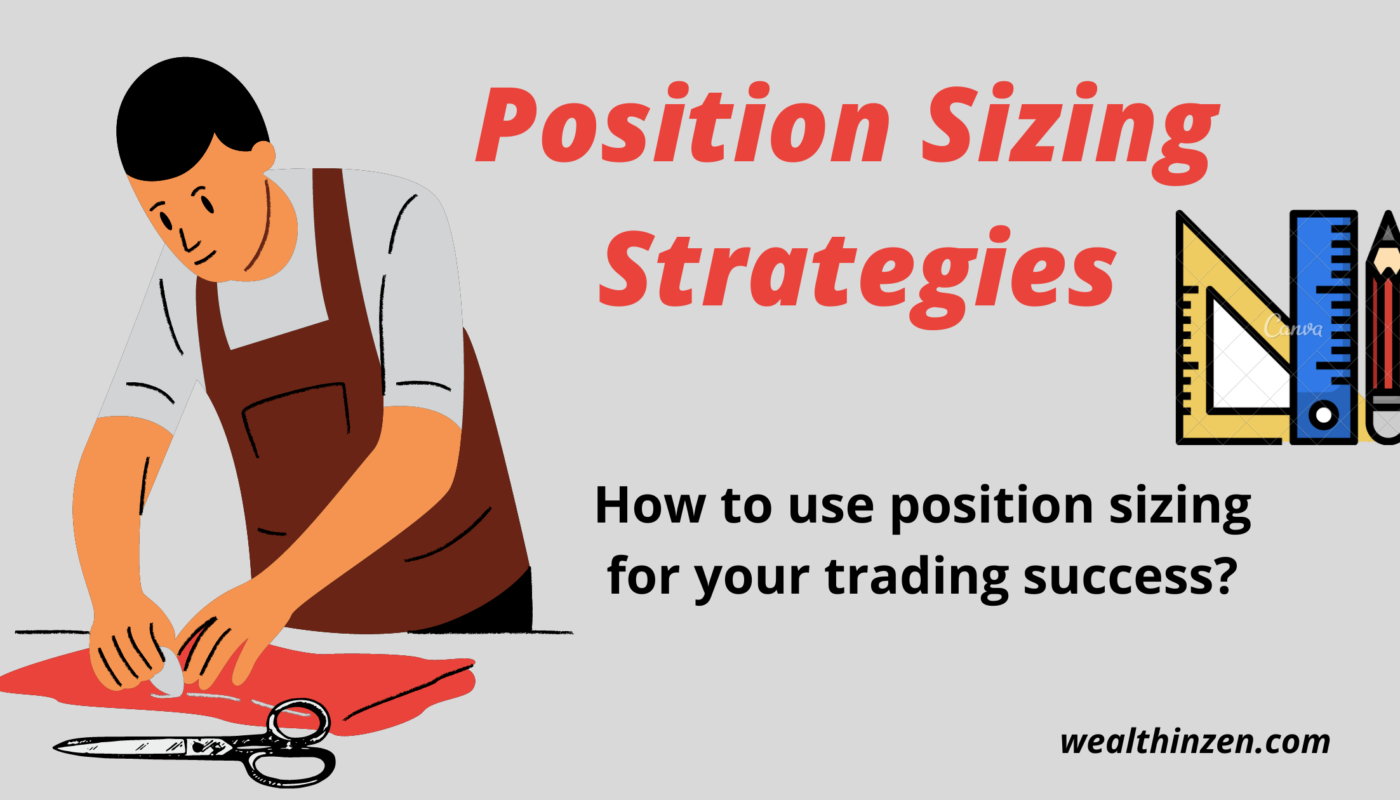Position sizing is an important aspect of trading and investing journey. It basically tells us how much shares to buy at what risk and how to manage a position to mitigate risk and drawdowns in a mathematical way. However this is also the most neglected part in many of the retail traders / investors.
Improper position sizing will give you inconsistent results and one may get below average results even if they have a good trading strategy. In this article we will discuss in short about various position sizing strategies and their pros and cons. Kindly, read the article to the fullest if you are starting your investing / Trading journey. I will also try to highlight how we can mix and match these strategies depending on individual needs and their portfolio size.
Why should one do position sizing?
When taking position in a stock, much time is given to analyze the stock. Whether you Invest in a stock based on its fundamental value or based on technical charts or both much importance is given to analysis.
However, the holy grail (if one has to be there) of the stock market success lies in how you manage the positions, both before and after taking the position.
You may have a strategy which has the ability to give you fantastic returns. It may be a well tested strategy. But, if you keep the position sizing different for different trades then the results will be different.
See the table below:
| Trade Number | Investment amount | Stock Price | Stocks bought | Risk: Reward ratio | Initial Risk in INR | Reward expected in INR | Win /Lose | Profit / Loss | Gain % |
| 1 | 10000 | 1000 | 10 | 1:2 | 100 | 200 | Win | +200 | 2% |
| 2 | 20000 | 1000 | 20 | 1:2 | 100 | 200 | Win | +200 | 1% |
In the above example, though all the criteria were same, depending on your investment amount the gain percentage is different. In the first trade, you gain 2% with the same risk reward concept, however in the second trade you gain 1% only even though the amount of profit (200 INR) is the same for both trades.
So, some elements of math are important in trading. Particularly, when you are trading / investing with a huge amount of money, if you don’t pay attention to size your positions properly, you are bound to get exposed to higher risk.
Position sizing strategies:
Van K. Tharp in his book “ Trade your way to financial freedom” explains four position sizing Models / Strategies as follows:
- Model 1: One Unit per Fixed Amount of Money
- Model 2: Equal Value Units for Stock Traders
- Model 3: The Percent Risk Model
- Model 4: The Percent Volatility Model
Model 1: One Unit per Fixed Amount of Money :
This is the simplest model of position sizing. Suppose, if you have 1 Lakh in your trading account, you buy only one position by investing the entire amount. If you see an opportunity in a stock and you believe your strategy and invest the entire 1 Lakh to buy the stock.
We have the maximum profit potential in this model as the investment amount is high.
But, we all know how dangerous it can be if the trade goes wrong. It simply means you are putting all the eggs in the same basket. So, the risk is also maximum in this model.
Managing risk and protecting the capital should be the priority of an investor. So, this model is not sufficient to survive in the market and this model works well all in theory and will fail in practicality.
Model 2: Equal value units for stock traders:
This model is somewhat better than the previous one. In this you divide your entire capital into segments and invest accordingly. So, if you have a capital of 1 Lakh what you basically do is, divide it into ten segments and invest 10,000 in 10 stocks. So, you have diversified your portfolio and you have a better opportunity of increasing your winning probability.
Even though this model looks safer, sometimes it is inefficient because you have to maintain equal values in all the stocks at any point of time. See the table below:
| Trades | Current Investment | Current Value | Percentage of Gain / Loss |
| Stock 1 | 10000 | 18600 | 86% |
| 2 | 10000 | 9800 | -2% |
| 3 | 10000 | 7900 | -21% |
| 4 | 10000 | 11000 | 10% |
| 5 | 10000 | 10500 | 5% |
| 6 | 10000 | 6500 | -35% |
| 7 | 10000 | 12200 | 22% |
| 8 | 10000 | 7500 | -25% |
| 9 | 10000 | 7100 | -29% |
| 10 | 10000 | 10900 | 9% |
Total portfolio gain percentage is 20%.
In the above table you can see that Stock 1 has given a return of 86%. You have five trades in the positive zone and five trades in the negative zone. However, since Stock 1 itself has given 86% it’s weightage in our portfolio has increased a lot. So, to maintain the equal amount condition as per the position sizing model, we should sell some of it and put in the stock which has lower current value.
This is exactly opposite to trend trading. Basically you are cutting the winner and adding your money to the losers, just to make sure that all the stocks are equally invested. Sure way for failure.
Another drawback is that you can divide the total 1 Lakh in any number of ways. You can divide it into five and invest 20,000 INR in each stock or you can divide it into two and invest 50,000 each and so on.
Also, it is not exactly possible to invest equally since the stock prices may vary. You just have to get a round off amount. For example, you want to invest 10000 in a stock that trades at 900. Then the closest amount you can invest is 9900 (900 * 11) and the 100 remaining you have to balance with some other stock or it has to sit idle in your trading account.
This insists on the need for a better position sizing strategy.
Model 3: The percentage Risk model:
This model allows us to decide the total loss / profit we will have on a percentage basis. For example, if your account value is 1 Lakh and you will be okay with a risk of 1% per trade (position) then your total loss will be limited to the number of positions you take.
If you take just two positions (buying two stocks) – your total loss will be 2% even if both the trades go against you.
If it is ten positions – your maximum loss will be 10% even if all the trades go wrong.
Thus, this model tells you how much you can lose if anything goes wrong.
In this model, the number of shares we can buy in a position and the total money we should invest in are calculated by using the formula as shown below:
Number of shares to buy = Total Risk of the entire account / (Buy Price – Sell Price)
Imagine you are planning to buy a stock of worth 1000 INR and you plan to exit the trade at 950. This 950 level may be a breach of pivot level or a breach of trend line, breach of moving averages etc., as per your strategy. You will exit the trade if it goes below 950 INR. Then the initial risk is (1000-950) = 50 INR.
Now, if you have already decided that you won’t risk more than 1% of your account of 1 Lakh then your total risk should be not more than 1000 INR (1% of 1 Lakh).
By using the formula as said above we can calculate the number of shares we can buy:
Number of shares = Total risk 1000 / (1000-950) that is 1000 / 50 = 20 Shares.
So, we got the number of shares we can buy without risking more than 1 percent of our account. If you see, to buy 20 shares trading at 1000 INR Each you will be investing only 20,000 of your 1 Lakh account.
You still have 80,000 remaining in your portfolio to take more positions based on the percentage model.
But, it is important to note that it is completely different from the equal value unit model we saw earlier. Suppose in the above example we saw, if you decide that you will exit the trade if the stock goes to 980 itself (imagine you are buying the stock at a close pullback or near a pivot) instead of 950, then your initial risk is 20 INR only.
Now, if you calculate
Number of shares = 1000 / (1000-980) that is 1000 / 20 =50 Shares.
To buy 50 shares the amount you will invest is 1000*50 = 50,000 INR.
You will be now investing 50% of your account in this single stock and your loss is limited to just 1%.
However, this model can be skewed at times as you may be investing large money in a single stock if the SL is small and will be investing very small in a stock if the SL is too big.
Model 4: Percent Volatility Model:
We all know the markets are always volatile. The up and down move that happens within a day is called the volatility of that particular day. In other words if you take the high and low of a candle and get the difference between the two it is called volatility. It is then converted into a percentage.
In a highly volatile market if you keep your stop loss too tight you are bound to be shaken out. The Percent volatility model tries to overcome this.
Here instead of keeping a pivot / moving average or a certain percentage as stop loss, we take the volatility percentage of a certain period as Stop Loss point. For this we use Average True Range (ATR).
If the Average true range for the past 14 days (most commonly used number, you can try your own combinations) is 6% then the stop loss is kept at 6% from the buy value. If you buy a stock of price 1000 and the Average True Range is 5% then your SL is 5% of 1000 that is (1000-50) = 950.
However, it is more practical only for people who have a trading system (Algo trading). For an investor / Trader who trades with manual discretion, this system is very complex, because you cannot keep on calculating the true range for each individual stock and then tallying them with the entire portfolio is another big task.
Also, the true range is dynamic and is not a constant. The day on which you buy the stock ATR may be 5% after 6 days it could change to 6% or if the market is too volatile may become 10% also, who knows?
How can we improve?
We had seen all the different strategies used for position sizing. The patience you have shown to read the article till here is commendable. Give yourself a pat for your interest in reading such a boring topic. But, once we master the position sizing we can trade / invest well in the long run.
Of the four strategies discussed above the first strategy (One unit per fixed amount) is very risky as there is no diversification and we cannot bet our entire portfolio on one stock.
The last strategy (Percent Volatility model) is said to be the best by Van K Tharp. However it has a lot of difficulties in practicality and is useful only if you do Algo trading based on systems.
So, we are left with second (Equal Value units) and third (Percentage risk model). Second model is superior in deciding easily how much to invest in each stock and the third model gives us more clarity on our risk and total number of shares we can buy exactly.
It is always good if we can mix these two strategies and use it for our investing. How can we do that? Let us see this step by step:
Decide your Total Drawdown Risk:
Drawdown risk is nothing but the loss you will have to bear if all the trades go wrong. This can happen in case of a crash or in case of a secular bear market where the market will be going down continuously for a longer period of time and eventually even though your stocks are good will also go down along with the market.
If your account size is ten lakhs for example, and you are willing to lose 10% then the maximum loss you can incur is 1 Lakh.
Decide Your Risk per trade:
This we can decide based on the percentage model. If you are okay with losing 2% per trade then your risk per trade should not exceed 20,000 per trade (for a 10 Lakh portfolio).
Decide the number of positions you can have the maximum:
This is very easy to decide now as we have decided the total risk we are willing to take (1 lakh) and the risk to be taken for each trade (2% of 10 Lakh- 20,000).
Number of trades or Positions you can take can be calculated as follows:
Number of positions = Total risk for the portfolio / Risk per Trade
For the above example it will be – 100000 / 20,000 = 5
So, we can take a maximum of 5 trades at any given point of time without losing more than 10% of our portfolio, even if everything goes wrong.
Decide the Number of shares per trade:
As discussed in the third model, we can calculate by using the formula:
Number of shares to buy = Risk per trade (20000 in our example) / (Buy price of stock – Sell Price)
Let us see the different scenarios we can have:
| Total Portfolio Size | Total Drawdown you can bear in % and INR | Total risk per trade you decide to have in % and INR | Number of positions you can take at any given time |
| 10,00,000 | 10% (1,00,000) | 2% (20,000) | (1,00,000 / 20,000) =5 |
| 6,00,000 | 15% (90,000) | 3% (18,000) | (90,000 / 18,000) = 5 |
| 6,00,000 | 10% (60,000) | 3%(18,000) | (60,000 / 18000) = 3.3 (so approximately 3) |
| 8,00,000 | 12%(96,000) | 2%(16,000) | (96000 / 16000) = 6 |
Key Takeaways:
- Position sizing plays a very important role for consistent results in the stock market.
- Among the strategies discussed Equal Value unit model and Percentage model works good if used in combination
- For traders who do “Algo trading”, a model based on volatility (model 4) may be a good alternative.
- It is important to decide the risk for the entire portfolio rather than deciding risk per trade only. It gives you more control when everything goes out of hand.
- Position sizing may be a little difficult concept for someone like me, who takes time to understand. So kindly re-read the concepts as many times as possible till you understand. Once you grasp the essence of it, it will be a cake walk.
All the points discussed in this article are based on my own understanding. Kindly do your own research before investing. In case of any doubt regarding the topic I am more than happy to help you.
You can write to me here: [email protected]



